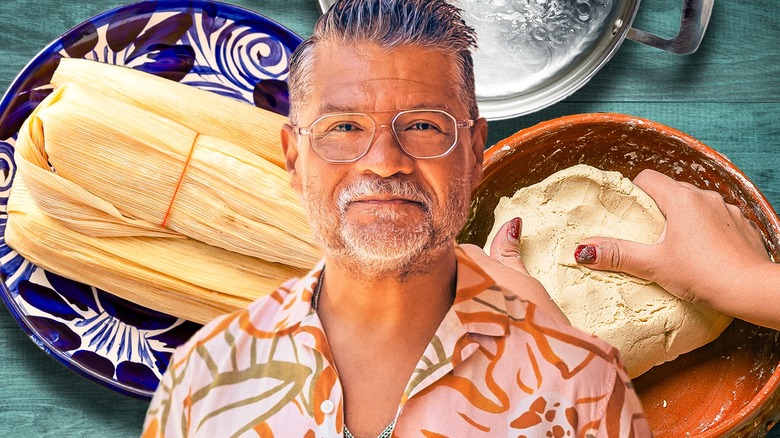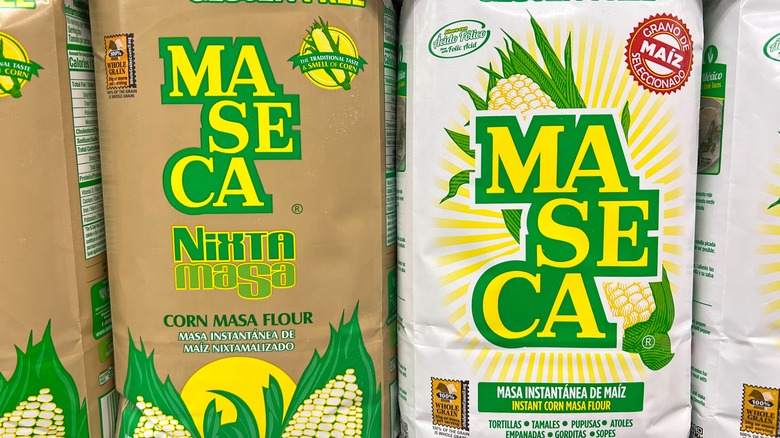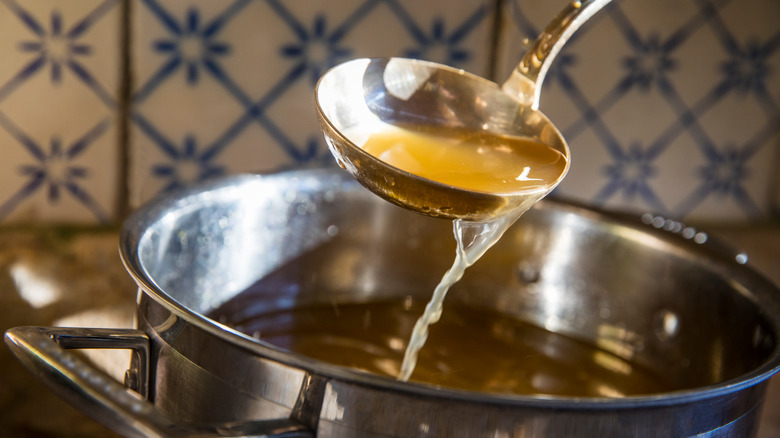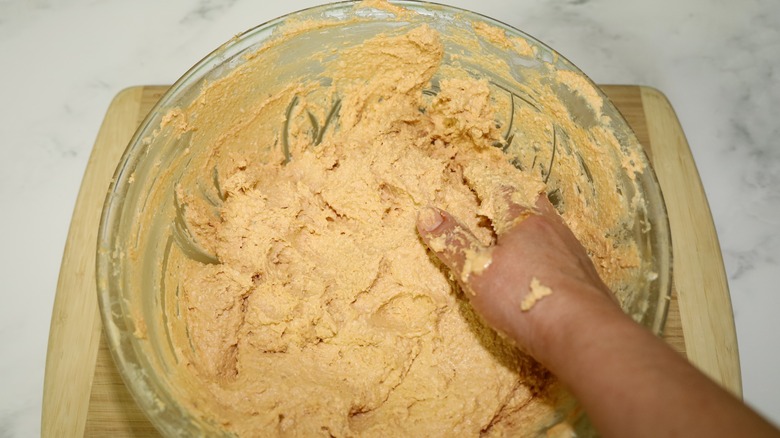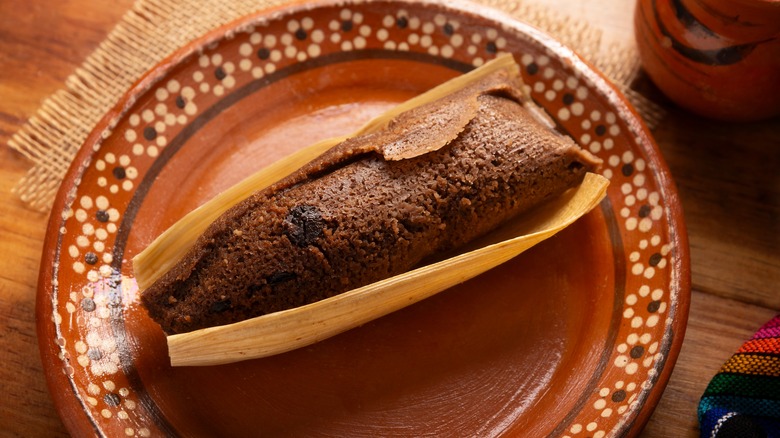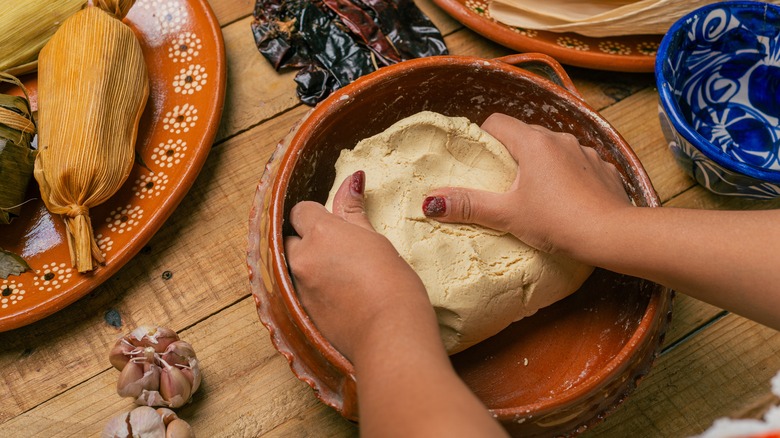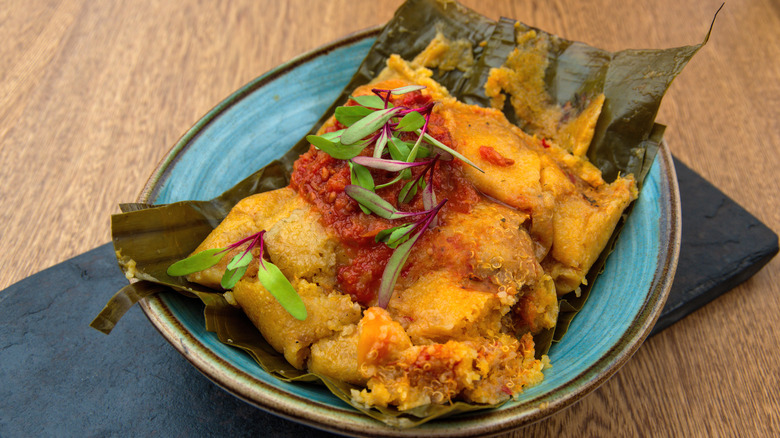Rick Martinez's Top Masa Tips For Tamales
We may receive a commission on purchases made from links.
Tamales are one of the oldest foods prepared and consumed in the Americas, with representations dating back to around 200 B.C. in the Mayan area of Mexico and Guatemala. As such, they are an important symbol in Mexican culture and cuisine, commonly present at the table during special occasions such as birthdays, weddings, and Christmas. Thankfully, this delicious tradition has traveled north, and now, many people across the U.S. enjoy making and eating them for the holidays. Tasting Table talked to chef and cookbook author Rick Martinez, who shared his expert tips for making masa at home for the best, fluffiest tamales. By the way, the correct name in Spanish is tamal for the singular, not tamale.
Growing up in Austin, Texas, Martinez used to make red pork tamales every Christmas with his family led by his mother, Gloria, from whom he learned the proper techniques to make masa. "When I went to culinary school, I had pitched this idea that I was going to make my mother's tamales, but by myself because I'd only ever made them with my family," Martinez says. "I took copious notes and I talked to her and she talked me through everything and she gave me the recipe." Mrs. Martinez would cook a hog's head and a pork shoulder with various chiles to make the filling. "She used chile ancho, guajillo, pasilla, 30 cloves of garlic ... We would normally make between 18 and 20 dozen [tamales]."
Mixing your own masa is easy
Making tamales is not hard, it's just a meticulous process that takes several steps. The first and most important step is making the masa, and the process will depend on the kind of corn flour you use. "Honestly, it's best to use the manufacturer's instructions in terms of the water amount because every variety of corn absorbs water differently," says Martinez. If you have access to freshly ground masa, you might need less water than if you start from a dry flour product such as Maseca, which is more readily available and works perfectly for making tamales.
"If you use Maseca, which is inexpensive ... it's going to absorb less water versus an heirloom variety is going to absorb a lot more water. And so I think it's just best to follow the water amount on the recipe," says the chef. This is also important since the texture of the masa in the recipe depends on the kind of tamales you're making. Some require a firmer masa, with a consistency resembling Play-Doh, while others need the masa to be spreadable, with a consistency closer to peanut butter. "If you add a little bit of baking powder to that, it will kind of have almost a pound cake texture," he adds.
Use warm water when mixing your masa
"I always use warm water. It doesn't have to be hot, it's just tap warm water," says Martinez. "[Warm water] helps the masa absorb the liquid, and it's the same thing with flour or any kind of grain. If you use cold water, it's just going to take longer for whatever you're soaking to absorb the water." He also recommends adding salt to the water to season the masa thoroughly and evenly. "I feel like if I'm going to use good masa, I'm going to taste it. But never put salt directly into the dough, because it just won't dissolve. You're going to bite into little grains of salt," he explains. "My rule of thumb is like it's a teaspoon of salt for a pound of anything. Obviously, you can adjust it if you want to add more, add a little bit less," says the chef.
Some recipes call for using broth instead of water to make a more flavorful masa. If you are using any seasonings, Martinez says that this is the right step to do it. "I would recommend putting the seasonings in some type of a liquid, dissolve it, and then pour it [into the masa]."
Adding oil or shortening is a must
One of the biggest differences between making masa for tortillas and for tamales is the addition of shortening. "For tortillas, you don't put oil in the dough. For tamales, you do," says Martinez. "That's basically the reason why that tamal comes off of the husk or the banana leaf or the paper." Most traditional recipes call for lard or shortening, but Martinez says you can use any oil. "If you're going to do a vegetarian [tamal], if you're going to use an avocado oil or an extra virgin olive oil, I would just make sure that it's not super aggressive ... I've had some avocado oils that I just find way too overpowering."
The amount of shortening also depends on the recipe, but don't be tempted to reduce it. "It's going to seem like a lot, so it could be a cup of oil, and people kind of freak out about that," says Martinez. "So the way that my dad used to do it, he would mix the oil into the dough and then ... with a clean hand, slap the top of the masa hard enough that you're going to leave a hand imprint on the top and then pull your hand out, and if any masa sticks to your hand, you need to add a little bit more." In this case, Martinez recommends adding an extra tablespoon or two at a time.
Consider adding extra flavor to the masa
"That is a little bit controversial in Mexico," says Martinez about adding extra flavor to the masa. "A lot of people, more so I think in the southern part of the country, are purists." He adds, "If you're using really good corn like they do in the southern part of the country, then yes, I 100% agree. But if you're not using the best corn with not a lot of flavor, then definitely spice it out." Sweet tamales are very popular in Mexico, and in this case, the flavoring usually goes into the masa. Cocoa, fruit preserves or jams, sweetened condensed milk, and spices such as anise and cinnamon are common additions.
"I'm also a big fan of if you have stock, if you have chili paste, if you have lard or lard that's flavored with chilies [mixing it into the masa]," says Martinez. At home, his mother would make a thick chili paste from the spiced liquid in which she cooked the meat for the filling. "So all the pork fat that had then been flavored and colored with all the spices, she would use that for the masa and also any residual liquid, she would take that and mix it with either chicken stock or pork stock, and then use that to flavor the masa."
How to prepare the masa for the fluffiest tamales
Mixing the masa to the right consistency has its tricks, but Martinez is here to help. "When I was little, my dad used to mix it. He was the masa mixer, but we were using 20, 25 pounds of masa, so it was gigantic," he says. "Now I only make a couple of pounds of masa at a time, so it's pretty easy. I prefer my hands and just because it's like kneading bread, there's just this really nice feel to it." However, as it's important to beat the masa to the right texture, its definitely fine to use a stand mixer with the paddle attachment. "You can change the texture of the finished masa, the final product, once it's cooked, by whipping air into it. So basically you either have to have a lot of upper body strength to do it by hand or put it in a stand mixer and just let it go as high as it can go for maybe between three and five minutes."
Some recipes call for whipping the lard before adding it to the masa, and this is way easier in a stand mixer since you want the lard to get very light and fluffy. "It'll work it's magic much quicker. And it's just going to get a lot lighter," says Martinez. "I don't think you can overmix it. I mean, honestly, I think you would hurt your upper body if you overmix it, you'd probably just stop from fatigue."
How to tell when the masa is ready
When he makes tamales using his mom's recipe, Martinez relies on his father's "slap test" to tell when the masa is ready, but he also shares a visual cue. "So the visual cue is that everything is well incorporated. So if you're adding a mix in, obviously they just need to be evenly distributed." There is also a tried and true Mexican trick for masa that is spreadable, as the slap trick won't work in this case. To know when the masa is ready, drop a tiny portion in cold water. If it floats, it's ready. If it sinks, keep whipping.
When your masa is ready, be sure your corn husks or banana leaves are thoroughly clean and dry before you start assembling the tamales. "And then when you spread [the masa] onto the corn husk or banana leaf or whatever you're using, you usually want to press it all the way down," says Martinez. Now that you're a masa expert, try our recipe for traditional tamales de rajas or these chicken and poblano tamales to surprise your friends and family.
